SHEEP PRODUCTION
The chief products of sheep are meat and wool
SHEEP BREEDS: Description and breed depend on presence or absence of horms and tail characteristics (fat or humped sheep)
EXOTIC BREEDS: These were introduced in East Africa in 1950. They include
i. Merino sheep (wool)
ii. Porper (multon or flesh)
iii. Romney marsh (dual purpose)
iv. Corriadated sheep (dual purpode)
v. Hampshire down(multon of fresh)
SHEEP MANAGEMENT
Selection and ailing are essential steps prepare sheep for mating. The ewe and ram should be down (i.e. tipping) before mating.
Dirty wool around the vulva and anus of the ewe and anus the ram should be dipped to prevent infection during mating.
Overgrown hooves should be trimmed to reduce the incidence of lareness.
Mating should be timed to ensure that lumbing takes place where there is plenty of grass and weather either too wet or too old. The best time is towards the end of the rainy seasons.
MANAGEMENT DURING GESTATION PERIOD
The gestation in ewes lasts for five months.
Management at this time should be aimed at maintaining heayhly ewes as this will guarantee survival of the unborn lamb.
The ewes should be vaccinated and drended to control diseases and internal parasites, dipping to control external parasites.
During the last month of pregnancy the ewe should be put on better food. SEAMING UP: 1-2 months before the ewe should be put on better food
This helps the foetus to grow rapidly and ensure the buildup of body reserve of fasta needed for milk production.
MANAGEMENT OF LAMBING
The ewe should be moved into a lambing padlock which has adequate shelter.
The correct way in which a lamb is born i.e. the head and forelegs first, however when the lamb is not correctly presented a farmer can assist the ewe by approaching quietly and after washing hands, the helper should examine the position of the lamb to determine the cause1 obstraction. When the position is accesed, the helper can gently pull the lamb; As soon as the lamb is born, the mother will lick after birth fluid and will allow her offspring to suck adostrum.
REARING OF LAMBS
During the first 4-6 weeks lamb are nourished by their mother’s milk.
Growth rate depends on the quality of the milk produced by the ewe.
Castaration of young lambs-ram not needed for breeding and docking of tails should be carried out during the 1st 2weeks.
At 6 month, the meat producing lamb are ready for slaughter-vaccination and dipping should continue
Shearing: When sheep are kept for woll,shearing should be done once per year around and is best done during dry seasons
DISEASE CONTOL
Diseases attacking sheep and goats on next page (same as goat).
GOAT PRODUCTION
They are purposely kept for meat and milk.
Breeds of goat: Most breeds are indigenpous and can be divided into two groups;
a) The Somali goats (dual purpose)
b) The small East African goats.
DAIRY GOATS: Jamna pati, Nubians, Saanen, Kamorai, Toggenberg MEAT GOATS: Somali, Turkana, Angola, Kamorai, small East Africa HAIR GOATS: Mohar, Boer, Angola, Kashmir
GOAT MANAGEMENT
In a well managed flock, mating should first take place 15-18months of age. Gestation periods last for 150days, therefore a goat can give birth twice a year
Meat producers: If the goats are kept for meat production, the young ones are left with mother until they are weaned.
Milk producers: The young ones should be removed from their mothers as soon as they are born and bottle/ bucket feed.
The kids should be fed3times during the first 3weeks and reduced to 2times per day until weaned 4-6months. A kid will need ½ litre of milk per day solid feed should be included from 2-3weeks after birth.
POST WEANING
After weaning kids will need good quality feed if they need to be fattened satisfactory, dipping and vaccination.
GOAT FEEDING
i. Goat brouse rather than grazing, during rainy season, they feed on green leaves and young shoots. As drying follows, they feed on fallen leaves, pods and sees, dry flowers, keads of grass and twigs.
ii. In confined conditions, meat producing goats may be fed on cut forages e.g. sweet potatoes, vines, green maize etc.
iii. Crop residues are also used particularly after cereal harvest.
iv. Milk producers are fed on similar way as in dairy cattle but in addition they will feed on roughages e.g. hay and silage.
o Concetrates should be fed on lactating goats to correct any mineral deficiency and roughage. Browsing: Feed on grass, shrubs and leaves.
Gut closure: Is the process whereby the gut becomes impemiable to absorption of immunoglobin especially 3 days.
BEE PRODUCTION
INTRODUCTION:
Species of bees suitable for keeping are:
i. Apis melifera
ii. Apis adonsoni
iii. Both are kept in highlands and in coastal areas.
ECONOMIC IMPORTANCE
They change nectar into honey from which wax is obtained and used in the manufacturing of candles, polishes etc.
Also bees help in pollination.
ORGANISATION OF THE BEE colony
i. The queen: Is a fertile female whose function is to lay eggs.
After the first mating she can lay eggs up to 4 years when she dies whereby one of her daughter takes over.
She produces a substance known as queen substance which the workers lick.
She lays up to 1500eggs per day.
ii. The drones: These are fertile males whose work is to fertile the queen. They are bigger than workers and don’t posses sting.
iii. The workers1: These are sterile females and can’t lay eggs. They do all the work in the hive e.g. collection of pollen and nectar from flowers, cleaning the cell, provision of ventilation by fanning their wings, feeding the larvae in cell, produce wax to build combs, to seal ripe honey and larvae and to guard the hive.
The comb: The workers build the comb in such a way that it consists of hexagonal cells/ chamber of different sizes.
i. The smallest cells are used for storing honey as pollen and rearing workers
ii. The middle sized cells are used for rearing drone and honey storage.
iii. The largest cells are oval in shape used for rearing virgin queens.
COLONY REPRODUCTION
i. All eggs hatch after 3days each larva has a head and 13 segments.
ii. The salivary glands of the “nurse bees” secrets a substance called “broad feed”. The nurse bees feed the entire larva on this broad feed for 3 days.
The queen larvae are fed on a royal jelly till they become pupa.
From the fourth day on wards the workers and drone larvae are fed for 6 days.
Workers and queen larvae are fed for 5days, while the drone larvae are fed for 6days.\
Queen takes 16 days to image, workers 21days while drones taken 24 days.
Usually there is in one queen per hive, before the young queen emerge from the cell, the old queen
Leaves the hive with thousands of workers i.e. swarming, the virgin that emerges first which then kills other virgin with her string She goes on mating flight she returns and becomes the new head laying queen on the colony.
MANAGEMENT PRACTICES DONE BY HUMAN BEINGS
Sitting the beehive: The place where bee hives are kept is called APIARY site
Factors affecting selection of a site:
i. For hanging hives: Should be hung on trees near a water source and well protected from wind.
ii. For standing hives: Should be sited at the centre of flowering plants.
Source of water should not be more than 1 1/2km far.
Site should have a natural protection against wind and sun.
Access of apiary should not face the entrance to hive.
Farm and other domestic animals should have no access to the apiary.
HARVESTING AND PROCESSING OF HONEY
TRADITIONAL METHOD
Smoke is blown into the hive through the entrance holes to drive away the bees.
The hive is lowered and turned over; the bottom board is opened to expose all the combs.
The light colored combs are cut while the old dark combs are left undisturbed.
After removing the combs the board is replaced.
The combs are put in boiling water to be melted.
The contents are stained through a cloth.
Any hardened wax from the surface of the honey is removed.
The honey is then slightly reheated in the water pan to make it more fluid then it is bottled.
IMPROVED METHOD
Before opening up the beehive smoke is blown in.
The frames are removed and the top of the cell is cut by knife to uncap the comb.
The honey is extracted with a machine.
The honey is strained to remove impurities then it is bottled.
HOW TO HANDLE BEES
Bees need careful handling considering the following:
Don’t approach the hive from the front.
Use smoke properly.
Don’t crush bees otherwise the whole colony will get excited
Avoid sudden movements.
If stung while handling a frame doesn’t pull out sting but remove them by scraping gently.
The beekeeper should protect him/ herself.
DISEASES AND ENEMIES OF BEES
Large animals e.g. honey badgers enter the hive and cause great damage.
Worm and parasites enter the hive through cracks and cause great damage.
Rain water leads to dampness which causes growth of moulds and fungi.
Ants are the greatest enemies, thus should be protected from ants by standing the legs in tines of water are used oil.
Wax moths cause great damage.
The bee house has parasites which lay eggs in the hive.
DIARY CATTLE
Meaning of
i. Dairying: This is the keeping of livestock in order to produce mainly milk and meat produce
ii. Dairy cattle: These are cattle kept in order to produce milk and milk products.
The role of Dairying in Tanzania
i. Provision of milk to adults and infants: Milk contributes as an important food for babies (infants) especially for mothers who for reasons produce less milk lows milk is rich in protein, fats, sugar and minerals which can also be fed to adult humans.
ii. Supplies milk products: The milk can be processed into many products e.g. butter, cheese, yoghurt and ice cream.
iii. Provision of manure: Cow during is good organic manure which improves soil fertility.
iv. Provides employment: People who keep dairy cattle get employment and on turn they can employ others for management.
v. Provision of foreign exchange: Through exportation of surplus doing dairy products to other countries.
LIMITATIONS OF DAIRY INDUSTRIES IN TANZANIA
1. Low production potential of local breeds: They produce very low amount of milk.
2. Shortage of foreign currency for purchasing exotic breeds: New breeds are needed in our country to improve production but there is a high shortage in foreign currency for the purpose.
3. Presence of diseases and parasites: Cause/effect production. E.g. FMD, Anthrax, Tuberculosis, Rind pest which are common in Tanzania.
4. Poor/ In adequate nutrition for the animals: Most cattle in Tanzania are grazed in natural pastures of which quality and quantity wise are low especially in dry season which affect milk production.
5. Presence of tsetse flies and ticks: Most areas in Tanzania are highly infected by tsetse flies and ticks causing nagana and East Coast fever respectively.
6. In adequate veterinary services: The number of veterinary personnel at present is too low compared to the numbers of livestock keepers.
7. Poor husbandry: Most livestock keepers in the country don’t know good principle of livestock husbandry resulting to low productivity.
8. Poor marketing and in adequate marketing facilities.
CHARACTERISTICS OF GOOD DAIRY COWS
i. Wedge shaped body: A cow with a wedge shaped body is narrow in front and broad at the back.
ii. Well developed udder: A good is one which is firmly attached to the body and is well suspended as well as large with well developed milk veins sagging udders tend to develop mastitis (inflammation of udder) good udder is of medium sized teats well spaced apart.
iii. Ability to secrete a lot of milk: A good dairy cow is of high genetic potential in milk production.
iv. Fertile and calves regularly: Milk production is facilitated by calving hence a fertile cow is able to calve regularly by this ensuring continuous milk production.
v. Docile temperate: A docile cow is ease to manage and easy to handle.
vi. Quick milk let down: This means that once you start milking it lets the milk quite easily and quickly.
vii. Milk with a high content of butter fat and proteins: This is of high quality.
viii. Long lactating period: A standard lactation period lasts for 30days: A good cow secrets milk as many days a possible.
ix. Resistant to diseases and parasites.
x. Tolerant to high atmospheric temperature i.e. able to resist heat stress experienced is tropical atmosphere
xi. Free from venereal and infectious diseases as they may cause infertility and produces milk free milk free from venereal/ infectious.
BREEDS OF DAIRY CATTLE
Terminology
In general, the same words are used in different parts of the world, but with minor differences in the definitions. The terminology described here contrasts the differences in definition between the United Kingdom and other British-influenced parts of world such as Canada, Australia, New Zealand, Ireland and the United States.
An “intact” (i.e., not castrated) adult male is called a bull. A wild, young, unmarked bull is known as a “micky” in Australia. An unbranded bovine of either sex is called a “maverick” in the USA and Canada.
An adult female that has had a calf (or two, depending on regional usage) is a cow.
A young female before she has had a calf of her own and is under three years of age is called a heifer. A young female that has had only one calf is occasionally called a first-calf heifer.
Young cattle of both sexes are called calves until they are weaned, then weaners until they are a year old in some areas; in other areas, particularly with male beef cattle, they may be known as feeder calves or simply feeders. After that, they are referred to as yearlings or stirks if between one and two years of age.
A castrated male is called a steer in the United States; older steers are often called bullocks in other parts of the world, but in North America this term refers to a young bull. Pik er bullocks are micky bulls (un castrated young male bulls) that were caught, castrated and then later lost. In Australia, the term “Japanese ox” is used for grain-fed steers in the weight range of 500 to 650 kg that are destined for the Japanese meat trade. In North America, draft cattle under four years old are called working steers. Improper or late castration on a bull results in it becoming a coarse steer known as a stag in Australia, Canada and New Zealand. In some countries, an incompletely castrated male is known also as a rig.
A castrated male (occasionally a female or in some areas a bull) kept for draft purposes is called an ox (plural oxen); “ox” may also be used to refer to some carcass products from any adult cattle, such as ox-hide, ox-blood, oxtail, or ox-liver.
A Springer is a cow or heifer close to calving.
In all cattle species, a female twin of a bull usually becomes an infertile partial inter-sex, and is called a freemartin.
Neat (horned oxen, from which neat’s-foot oil is derived), beef (young ox) and beefing (young animal fit for slaughtering) are obsolete terms, although poll, pollard or polled cattle are still terms in use for naturally hornless animals, or in some areas also for those that have been disbudded or dehorned.
Cattle raised for human consumption are called beef cattle. Within the American beef cattle industry, the older term beef (plural beeves) is still used to refer to an animal of either sex. Some Australian, Canadian, New Zealand and British people use the term beast, especially for single animals when the sex is unknown.
Cattle bred specifically for milk production are called milking or dairy cattle; a cow kept to provide milk for one family may be called a house cow or milker. A “fresh cow” is a dairy term for a cow or first-calf heifer that has recently given birth, or “freshened.”
The adjective applying to cattle in general is usually bovine. The terms “bull”, “cow” and “calf” are also used by extension to denote the sex or age of other large animals, including whales, hippopotamuses, camels, elk and elephants.
Dairy farming in Tanzania is based on European breeds and crosses with indigenous zebu.
a) Friesian (Holland origin)
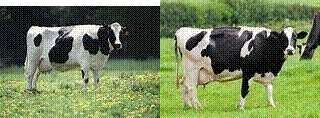
White and black in colour
Average mature weight 550kg
Milk has low butter fat content 3.5-4%
Calves are born large (35-40kg) and heifer under good management calves at the age of 21/2years.
The udder has a very large capacity with milk yield 3500litres/ lactation.
b) Jersey (Origin: Jersey island in the English Channel)
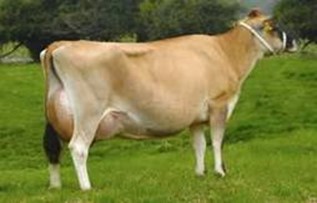
The Jersey cow is quite small ranging from only 400–500 kilograms (880–1,100 lb). The main factor contributing to the popularity of the breed has been their greater economy of production, due to:
The ability to carry a larger number of effective milking cows per unit area due to lower body weight, hence lower maintenance requirements, and superior grazing ability.
Calving ease and a relatively lower rate of dystosia leading to their popularity in cros breeding with other dairy and even beef breeds to reduce calving related injuries.
High fertility
High butterfat conditions, 4.84% butterfat and 3.95% protein, and the ability to thrive on locally produced food. Bulls are also small, ranging from 540 to 820 kg (1200 to 1800 pounds), and are notoriously aggressive.
Castrated males can be trained into fine oxen which, due to their small size and gentle nature, make them popular with young teamsters. Jersey oxen are not as strong as larger breeds however and are generally out of favour among competitive teamsters
Light animal and horned
Heat tolerant
Yellow- brown colour
Wedge shaped body with level top
High butter fat content of 5% – yellow
Heifer calves down cut 2-21/2 years of age
Low food requirement hence suitable for small scale.
Calves are light 20-25kg
Produce 2300litres/ lactation.
c) Aryshire
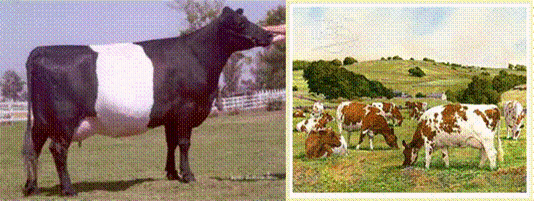
Medium heavy breed
Mature cow weighs 450-500kg
Drought resistant
Have red and white patches on skin
Average milk yield is yield 3300litres/ lactation with butterfat content of 4%.
Calves born at average weight of 30-35kgs and age 21/2years.
d) Guernsey (Origin: Island –English channel)
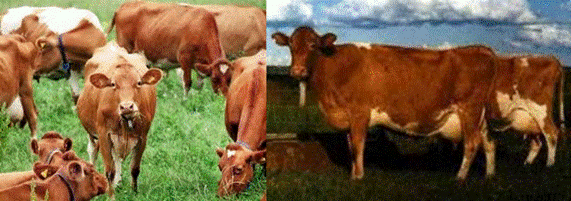
They are brownish except legs and bottom part whish are white.
Produces over 2500litres/ lactation with 5% butter content.
Calves are born at an average weight of 25-30kgs.
Its horns inwards and forward.
Mature cow weights 450-500kgs.
Heifer calves are at the age of 21/2years.
DUAL PURPOSE BREEDS
i. Sahiwal (Origin: Indian subcontinent)

Best dairy breed in tropics
Well developed udder and long thick teats
Milk yield varies from 1800-2000l/ lactation
Heavily built with short legs
Difficult milking due to thick teats
Mature cow weighs 400kgs
Heifer calves at the age1 of 3years
Reddish brown colour
Resistant to tropical diseases
ii. Mpwapwa (developed at Mpwapwa livestock breeding station)
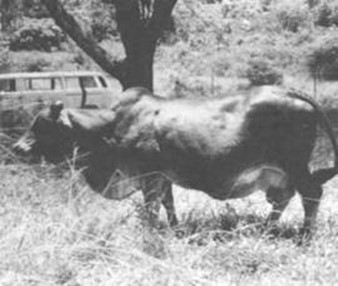
Have brownish colour
Have big ears which face down wards
Survive well in semi arid areas
Have long face slightly protruding from out side
PLANNING AND DESIGNING A DAIRY FARM
Factors to be considered when planning a dairy farm
1. Consider the site: Include; climatic condition, location (will influence transport), water accessibility, veterinary services availability
2. Topography: This will influence drainage.
3. Flexibility: Space for future expansion.
4. Economic point of view of the enterprise.
5. Legal aspects and public opinion.
6. The system that is to be used in feeding animals.
BASIC REQUIREMENTS OF A WELL DESIGNED ANIMAL HAVE;
Farm accessibility to fresh water
Sufficient light and ventilation for satisfactory inspection
Should allow sufficient freedom of movement of animals
Should have a facility of emergency provision in the event of breakdown of the existing equipment
The floors and walls should not harm the animals.
The internal surface should be easily disinfected and cleaned.
Provide adequate: bedding especially for calves, dry lying areas for animals and facilities for disposal of waste material.
MAJOR COMPONENTS OF A DAIRY FARM
A good has the following features: Fences, crushes, water supply, dipping tank and dairy basin.
1. Dairy barn: It is a building which provides animals with protection against wind, sunshine, rain, etc.
Helps to avoid cattle disease infections.
Also it is used to store machinery, feeds and other equipment.
It is composed of -dairy room for milk storing
stores for food and equipments
cattle pen
a cow shed
passage
water trough
2. Dipping tank/ spray place: It is a structure used to apply a caricide to kill ticks and other ecto- parasites.
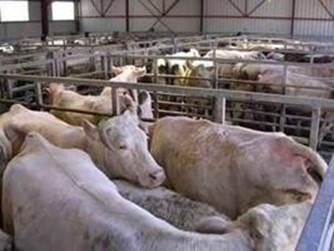
It consists of a collection area and a passage leading to a tank which contains the acaricide solute.
Below the tank there is a foot path (in the passage) which contains a caricide or CuSO4 solution, this will stop them from spoiling the solution.
Drainage race (yard) where it is reduces wastage of acaricides as well as contamination of pastures.
3. Water supply: Water is need for drinking, cleaning and dipping. It is preferably be a water tap.
4. Crushes: This is a passage constructed by use of timber, wood or metal pipes.
Used to hold cattle in several operations e.g. vaccination, hand spraying, drenching and artificial insemination.
5. Assist in controlling grazing hence prevents overgrazing.
Also facilitate mixed farming
Keeps out intruders. FARM LAYOUT
Dairy house crushes/ spray race and water through
Calves paddocks-Near entrance to the farm or behind dairy houses.
Crush and dip found AT THE BACK OF A DAIRY HOUSE: If no slightly sloping land.
Grass grazing for adult grown up heifer and those fodder crops should be separated by farm roads.
MANAGEMENT OF CATTLE ON DAIRY FARM
The herd of cattle which are kept in a dairy farm is composed of:
Calves: these are young cattle at either sex.
Heifers: these are young female cattle 9-18months age.
Cows: these are mature female (heifer become a cow after calving)
Bulls: these are mature male cattle which are not castrated. Kept so as to make with cows and heifers
Steers: these are male cattle which have been castrated.
MANAGEMENT OF THE BREEDING STOCK
This consists of mature heifers, cows and few bulls; which mate with female mature heifers and cows.
When the females conceive they are said to be in calf heifers or calf cows. Gestation period in 280 days
NB:
i. Only fertile cattle should be put in the stock.
ii. Mature heifers / cows can be inseminated artificially.
BREEDING TIME:
Bulls may be kept together with cows and where bulls are allowed to mate the cows throughout the year. This is called continuous breeding: alternatively the bulls may be kept separately from female cattle and allowed to make certain period of the year. This is known as CONTRLLED/ SEASONAL BREEDING.
SUPPLIMENTARY FEEDING: Heifers: When they reach 15-18 months old (maturity) they should1 be fed on concentrates, with at least 19% and protein (CP) at a rate of 1.5-2kg/day.
Suitable breeding time
Heifer/ cows reach seasonal maturity when an ovum is released from one of the ovary.
Sighs of heat
Restlessness
Isolation from other cows: tend to stay away from others.
Mounting other cows
Jelly like fluid discharged from vulva.
Drop in milk yield
Calf management
Immediately after it’s born: Nose and mouth cleaning, placenta removed after birth and colostrums provision within 4days.
Colostrum: First milk from cow within 2-3 days rich in immunoglobin
Functions:
o Laxutive i.e. helps calf to be ejected, the first faces accumulate in alimentary canal of the calf as it grows.
o Digestive system of a calf is able to absorb antibodies or immuneglobin
o Highly digestible and nutritive rich in vitamin A.